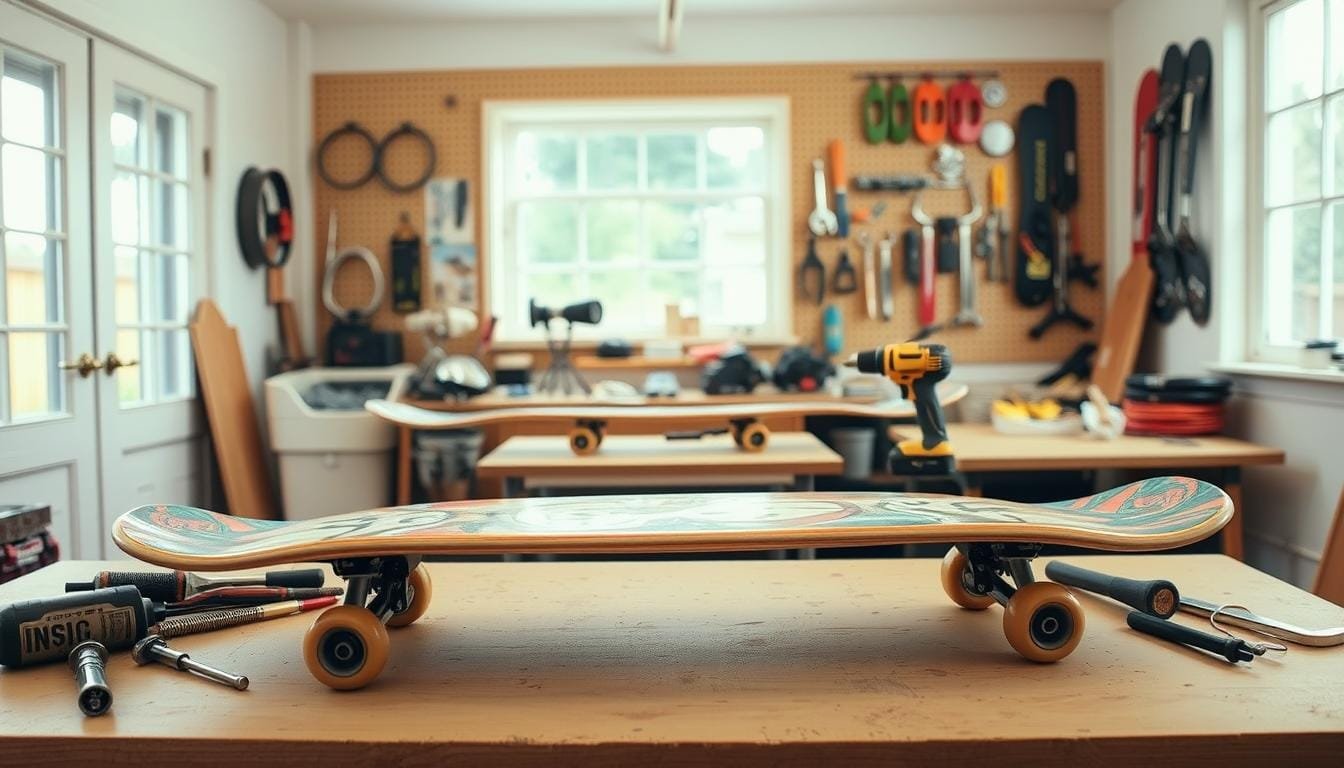Feeling tired of those hard, high-impact landings on your traditional skateboard? Want a smoother, more enjoyable ride? Good news! You can convert your skateboard into a cruiser to better your skating. This switch is perfect for anyone wanting to easily glide over different surfaces, either while commuting or just for fun.
This guide gives you all the steps and tips you need for a great skateboard conversion. By following this advice, you can change your standard skateboard into a comfy and smooth cruiser skateboard.
If you’re an experienced skateboarder or a beginner interested in DIY skateboard modification, you’re in the perfect spot. Let’s get into how you can make this fun change happen.
Start transforming your skateboard today by checking out the steps here.
Key Takeaways
- Turning a skateboard into a cruiser makes riding more comfortable.
- A cruiser skateboard is great for easy rides across different areas.
- You’ll need to change the decks, wheels, trucks, and bearings for major changes.
- To ride smoothly, soft wheels (78A durometer) are key.
- Doing the modifications yourself saves money, costing about $76.34 in total.
Understanding Skateboard Types: What Is a Cruiser?
Cruiser skateboards are great for city rides and relaxed journeys. They’re different from traditional skateboards and longboards. They’re designed for smooth, comfy rides. Most cruisers are 30” to 37” long. This size helps you move easily and stay stable, no matter the terrain.
Cruiser decks are usually 28” to 34” long and 8” to 10” wide. This gives you more room for your feet. They are often made of 7-ply Canadian maple. This material is both tough and bendy. For example, the Fireball Artist Series. It includes decks for $69.95 and full setups for $134.95.
For trucks, cruisers commonly use traditional kingpins (TKPs). These trucks make the board agile and keep it low for easy control. Truck widths range from 109mm to 200mm. This lets riders pick trucks that suit how they like to skate.
The wheelbase of cruisers starts at about 14”. This impacts how stable and quick to respond the board is. Cruiser wheels mix longboard and skateboard wheel traits. They range from 52mm to over 80mm in size. With a hardness of 78a to 80a, they can go smoothly over bumpy roads.
Cruisers stand out for their flexibility and simple use. They’re great for getting around and short trips. They give you a smooth ride, like longboards, but are easier to carry. Their softer wheels and adjustable trucks give you a feeling like surfing on land.
While traditional skateboards are for tricks and skateparks, and longboards for speed and long rides, cruisers are perfect for chill, everyday use. Cruisers mix qualities from both, making them loved by new skaters and pros.
Benefits of Converting to a Cruiser
Switching your skateboard to a cruiser can change how you ride. The biggest plus is the comfort it brings. Cruisers have bigger, softer wheels that soak up road bumps, making them great for rough spots.
Cruisers offer better control too. Their decks are wider, from 25” to 32” long and 7” to 9.5” wide, giving you more stability. This helps with balance and ensures your feet fit well. Wheel-wells on cruisers also help with sharp turns and stop wheelbite.
A cruiser’s versatility stands out as well. They’re not just for tricks but great for short trips and casual rides. Many cruisers come with a kicktail, letting you do basic tricks easily. Yet, cruising smoothly is their main goal.
For a top-notch ride, wheels should have a durometer of 76A to 80A. With diameters between 58mm and 65mm, these wheels make rides softer over bumpy roads.
Want a board that’s great for the city or a easy ride around the block? Converting to a cruiser has lots of benefits. It turns your board into a fun and handy way to get around.
Let’s compare traditional skateboards to cruisers:
| Feature | Traditional Skateboards | Cruiser Skateboards |
|---|---|---|
| Deck Length | 28”-32” | 25”-32” |
| Deck Width | 7.5”-8.5” | 7”-9.5” |
| Wheel Size | 50mm-54mm | 58mm-65mm |
| Wheel Durometer | 95A-101A | 76A-80A |
| Primary Use | Tricks/Skateparks | Commuting/Cruising |
Essential Modifications for Your Skateboard
Turning your skateboard into a better cruiser means making some changes. First, switch your standard wheels for larger, softer ones. Soft wheels around 78A absorb bumps well, making rides smoother. They start at 58mm, providing the cushion you need for different surfaces.
Then, upgrade your trucks for better control. High-quality trucks improve how you turn and avoid obstacles. It’s important to match your trucks’ axle width with your deck for stability. An 8.0″ truck works well for decks that are 8″ to 8.5″ wide. Use high trucks for wheels 56mm or larger.
Soft bushings help with sharp turns, while hard ones keep you stable at speed. This choice affects how your skateboard feels and handles. It’s good for both new and experienced skaters.
Riser pads are great for avoiding wheel bite, making turns safer. They also help your skateboard deal with bumps better. Adding shock pads further increases comfort by absorbing road vibrations.
Strong bolts and nuts keep your skateboard together. This prevents parts from loosening with time. Don’t forget new grip tape for better control and safety on your board.
Make your skateboard reflect your style with stickers and graphics. Adding tail and nose guards keeps your deck looking good longer. Personal touches not only look great but also protect your board.
Updating your skateboard carefully improves your ride a lot. Choosing the right wheels, trucks, and other parts makes skating more fun. Every change, big or small, enhances your cruising experience.
Tools and Materials You’ll Need
Making your skateboard into a cruiser needs essential tools and materials. Here’s a list to start your DIY project:
For shaping your deck, a jigsaw is necessary. You will need sandpaper from 80 grit to 600 grit for a smooth finish. A strong varnish is key to protect your deck from weather.
Baltic birch plywood is the best choice for the deck, costing about $13.00 for a 5×5 sheet. You’ll need to cut it into 1-foot by 5-foot strips, at least four of them.
Use 12 clamps while gluing, but 20-30 clamps give better results. Let the glue set for 24 hours for strong adhesion. For staining, mix 40cc water with 12 drops of blue food coloring.
Put on 4-5 layers of wipe-on polyurethane for a strong finish. Each coat needs 2-3 hours to dry. To install the trucks, mark 2 inches at the front and 6 inches at the back. Drill holes using a 3/16 inch drill bit. Tighten the hardware again after a few rides for safety.
Learn about the best skateboard trucks for cruising here. Consider riser pads, which cost between $5 and $10.
To build a cruising skateboard, you’ll need a deck ($50–$80), cruiser wheels ($30–$60), bearings ($10–$50), and trucks ($20–$50). You will spend about $115 to $250 in total.
For more tips on turning your skateboard into a cruiser, check this resource.
Step-by-Step Guide to Transforming Your Skateboard
Ready to start making your DIY cruiser skateboard? This easy guide will show you how to turn a regular skateboard into a cruiser. It’s perfect for both experienced skaters and beginners.
First, make sure you have everything you need. This includes a skateboard, a new deck, grip tape, wheels, bearings, trucks, and maybe shock pads. Buying quality parts from well-known brands like Fireball can make your cruiser last longer and perform better. You can get a Fireball Artist Series cruiser deck for $69.95, and a full setup for $134.95.
- Remove Existing Components: Use a skate tool to take off the wheels, trucks, and old grip tape. Make sure you get everything off for a fresh start.
- Prep the Deck: Put new grip tape on the bare deck. A cruiser skateboard usually is 30” to 37” long and has a 21” to 50” deck size.
- Shape and Drill Holes: Cut and reshape the deck to the cruiser style you like. Drill new holes for the trucks if the old ones don’t fit.
- Install Trucks: Fix the trucks to the deck. The trucks should be the right width, between 109mm to 200mm, for a smooth ride.
- Select and Install Wheels: Pick cruiser wheels between 52mm and over 80mm in diameter. Softer wheels, 78a to 80a, are better for cruising on rough surfaces.
- Install Bearings: Put high-quality bearings in the wheels for a smooth ride. Be careful of misleading “ABEC ratings” from some companies.
- Final Assembly: Attach the wheels to the trucks and check everything is secure. Use a torque wrench to tighten everything well.
Lastly, think about adding shock pads to lessen road shock. They can greatly improve your cruise. Make sure to adjust everything properly for a safe and fun ride.
| Component | Specifications |
|---|---|
| Deck Length | 30” to 37” |
| Truck Width | 109mm to 200mm |
| Wheel Diameter | 52mm to 80mm+ |
| Wheel Durometer | 78a to 80a |
| Shock Pads | Optional |
| Bearings | High-Quality (Avoid Misleading ABEC Ratings) |
Now you have the step-by-step skateboard modification instructions, you’re ready to turn your skateboard into a cool cruiser. Enjoy making it and have fun cruising!
Tips for Enjoying Your New Cruiser
You’ve just upgraded your skateboard to a cruiser – that’s awesome! Your cruiser is now set for amazing rides. First up, scout for the best spots to cruise. Look for places like boardwalks and park pathways. These spots have the smooth surfaces and gentle slopes ideal for cruising. They let you enjoy beautiful views while you get the hang of your board.
Keeping your cruiser in great shape is crucial. Make sure to regularly inspect your skateboard components. Check that the trucks are tilted at about 45 degrees for better slides and turns. Take care of your bearings too, to help them last up to two years. Also, choose wheels with a hardness rating from 90a to 100a. This ensures a good balance of grip and durability.
Next, work on improving your skateboarding skills. If you’re just starting, learn to brake with your foot. This method helps you control your speed safely, even up to 60 mph. Always wear safety equipment like helmets and knee pads to avoid getting hurt. Stretch both before and after riding to stay limber and avoid soreness. Remember, the key to a great skateboarding experience is to find a balance between having a good time and staying safe.

I’m John Peterson, a passionate skater, blogger, and lifelong enthusiast. I’ve been skating for over 9 years and have gone on to write a blog dedicated to the sport of skating and its culture. Through my blog, I strive to share my knowledge and experience of the sport with all who are interested. From beginner tips, tricks, and equipment reviews to interviews and event coverage, I cover it all. So read my blog as I explore the wonderful world of skating!

